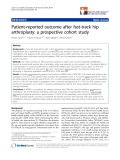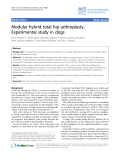
THAI BINH JOURNAL OF MEDICAL AND PHARMACY, VOLUME 16, ISSUE 2 - MARCH 2025
37
PREVALENCE OF HYPOTHERMIA IN ELDERLY PATIENTS UNDERGOING
HIP ARTHROPLASTY
Nguyen Khanh Trong Thien1, Bui Dinh Hoan1,
Doan Minh Nhut1*, Tran Thi Mong Nghi2,Le Van Dung2
1. University of Medicine and Pharmacy at Ho Chi Minh City
2. Cho Ray Hospital
*Corresponding author: Doan Minh Nhut
Email: doanminhnhut@ump.edu.vn
Received date: 15/2/2025
Revised date: 20/3/2025
Accepted date: 29/3/2025
ABSTRACT
Objectives: To determine prevalence of
hypothermia in elderly patients undergoing hip
arthroplasty
Methods: A prospective, cross-sectional
descriptive study was conducted. Tympanic
thermometers were used to measure body
temperature in patients aged 60 years and older
who underwent hip arthroplasty under general
endotracheal anesthesia at the Department of
Anesthesiology, Cho Ray Hospital, from December
2022 to December 2023. Body temperature
was measured at the following time points: pre-
anesthesia, induction, and 10, 30, 60, and 90
minutes after induction, as well as at the end of
surgery.
Results: The incidence of hypothermia in hip
arthroplasty surgery in elderly patients was 38.67%.
Mild hypothermia was the most common (25.3%),
followed by moderate hypothermia (13.3%), with
no cases of severe hypothermia reported.
Conclusion: Hypothermia in hip arthroplasty
among elderly patients has a relatively high
incidence, accounting for more than a quarter
of cases. Strict temperature monitoring and
appropriate preventive measures are crucial to
reducing perioperative risks.
Keywords: Hypothermia, Surgery, Hip
Arthroplasty
INTRODUCTION
Intraoperative hypothermia is a common issue
across various surgical specialties. Despite the
availability and effectiveness of warming methods,
the incidence of hypothermia remains high among
surgical patients, ranging from 4% to over 70%
[1,2]. One possible reason for this variability is the
ineffective use or lack of emphasis on warming
measures. A survey on intraoperative hypothermia
across 17 European countries revealed that active
warming systems were employed in only 38.5%
of cases, and surgical temperature monitoring
was conducted in merely 19.4% of patients [3].
Furthermore, other studies have reported a high
incidence of hypothermia (T < 36℃) upon patient
transfer to the postoperative care unit, even when
warming systems were utilized [4,5].
Intraoperative hypothermia leads to severe
complications both during and after surgery. It
has been associated with numerous adverse
outcomes, including postoperative cardiovascular
events, intraoperative bleeding, altered drug
metabolism, and postoperative infections [6,7,8].
Additionally, hypothermia may prolong ICU stays,
reduce thermal comfort and patient satisfaction,
and increase treatment costs [9,10].
Elderly patients are more susceptible to
hypothermia than younger individuals in both
cold environments and the operating room. This
increased risk may be attributed to factors such
as inadequate nutritional intake, lower physical
activity levels, or a reduced vasoconstriction
threshold compared to younger patients [11]. In
orthopedic surgery, particularly hip arthroplasty,
preventing hypothermia requires greater attention,
as these patients are often elderly and at high risk
for complications and infections. Periprosthetic
joint infection following hip arthroplasty can lead to
significant medical consequences, with a reported
mortality rate of up to 2.5% [12].
This study aims to investigate the incidence of
hypothermia in hip arthroplasty among elderly
patients to assess the prevalence and clinical
significance of this issue. The findings will assist
physicians and nurses in developing effective
monitoring, care, and intervention strategies to
prevent complications and enhance patient safety
during and after surgery. Therefore, we conducted
a study with the aim of determining the incidence
of hypothermia in elderly patients undergoing hip
replacement surgery under general anesthesia.
II. SUBJECTS AND METHODS
2.1. Subjects
This study was conducted on 75 patients aged
60 years and older who underwent hip arthroplasty












